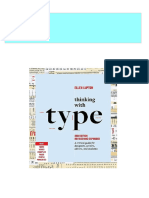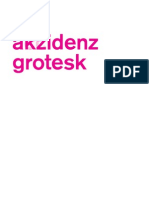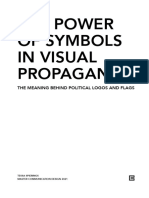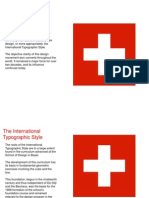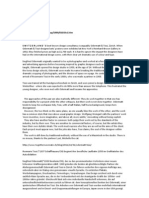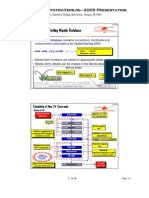Armin Hofmann Press Release
Armin Hofmann Press Release
Uploaded by
adga rwerweCopyright:
Available Formats
Armin Hofmann Press Release
Armin Hofmann Press Release
Uploaded by
adga rwerweOriginal Description:
Copyright
Available Formats
Share this document
Did you find this document useful?
Is this content inappropriate?
Copyright:
Available Formats
Armin Hofmann Press Release
Armin Hofmann Press Release
Uploaded by
adga rwerweCopyright:
Available Formats
Press release: Exhibition
Armin HofmannFarbe
A project by Fabienne Ruppen and
Christof Nssli
www.armin-hofmann.ch
August 30September 28, 2012
Opening: Wednesday, August 29,
starting at 6 p.m.
Season opening of the Zurich galleries:
August 29/30/31, 2012
Galerie Susanna Kulli
Dienerstrasse 21, CH8004 Zrich
T +41 43 243 33 34, F +41 43 243 33 35
www.susannakulli.ch
TueFri 16 p.m., Sat 11 a.m.4 p.m.;
extended hours Wed 68 p.m.
It has always seemed to me that there must be a life of color as such, divorced from any object. (Augusto
Giacometti, Die Farbe und ich, 1933)Until now, the reception of Armin Hofmanns oeuvre has focused on this
renowned Swiss graphic artists posters, which are largely in black and white. The exhibition at Galerie
Susanna Kulli now offers the first in-depth look at his intense engagement with color. Its centerpiece is a
portfolio of silkscreen prints that is unique in Hofmanns oeuvre.
The silkscreen portfolio is complemented by writings and sketches from Hofmanns private archive and
problems he assigned in his classes. Recollections of four of his former studentsPhilip Burton, April Greiman,
Aki Nurosi, and Moritz Zwimpferopen up new perspectives on Hofmanns close engagement with
issues of color.
Each of the twelve plates in the portfolio, created between 1989 and 1999, shows four triangles arranged
in a square. By eliminating light-dark contrasts, Hofmann was able to focus on color as such and the contrasts
specific to itcoldwarm and luminousdull, as well as contrasts in hue and quantity. As Hofmann emphasizes,
the twelve plates should not be regarded as final results; they are guideposts in a process, and their order
is variable. The reduction to a single problem held constant led him to a more nuanced vision and a growing
awareness of the sensual qualities of color: When you work in this manner, you become
ever more refined, more sensitive.
In his teaching, too, Hofmann sought to raise his students sensitivity for the qualities and effects of color.
He had no interest in imparting an authoritative system of color, striving instead to accommodate the individual
element in color perception. Of particular interest in connection with the silkscreen portfolio, which Hofmann
describes as a sort of account of my pedagogical activities, is a problem he assigned in a class in 1984. The
extant sketches produced by the students and their final results bear considerable compositional and
chromatic resemblance to the twelve plates in Hofmanns portfolio.
Two case studiesof the former PTT-Areal in Arlesheim and the high school in Disentisfurther illustrate
Hofmanns use of color in three dimensions. Both buildings were designed by the architects Hermann and
Hans Peter Baur, early advocates of an integration of the arts into architecture; during the almost six decades of
their collaboration with Hofmann, they frequently involved the artist in the planning process from the very outset.
Art for public spaces was the only field of his practice in which Hofmann employed color as a defining
artistic element. As in the silkscreen portfolio and in his classes on color, the study of the relativity of chromatic
values was central. The critical examination of the role of the mark in its context pervades Hofmanns entire
oeuvre. The engagement with color added another layer to this complex issue and may be seen as bringing
further nuance and elaboration to his teaching of form.
We would also like to bring our
evening events to your attention:
Thursday, September 6
Teaching color (in German)
A panel discussion with Marcella
Wenger-Di Gabriele (Haus der Farbe,
Zurich), Ulrich Bachmann (Institut fr
Farbe und Licht IFL, Zurich), and
Moritz Zwimpfer (graphic artist and
writer, Basel)
Thursday, September 13
Have you noticed? Color as an
interface between art and
architecture (in German)
A conversation between Mike Guyer
(Gigon/Guyer architects, Zurich)
and Adrian Schiess (artist, Zurich),
moderated b
y Stefan Wagner
(independent art historian, Zurich)
Both events begin at 7:30 p.m.
Admission is free.
Armin Hofmann (b. Winterthur, 1920)
lives in Lucerne. After training as a
lithographer, he worked as a freelance
graphic artist; clients included the
Stadttheater and the Kunsthalle in Basel.
For many years, he taught at a variety
of institutions, including the Allgemeine
Gewerbeschule Basel (AGS, now Schule
fr Gestaltung Basel/Basel School
of Design), where he and Emil Ruder
initiated the advanced visual design
class in 1868; the Yale University School
of Art in New Haven; and the National
Institute of Design in Ahmedabad.
Armin Hofmanns works are held
by international collections and have
been presented in numerous solo and
group exhibitions; his textbook
Graphic Design Manual (published
by Niggli-Verlag) has become a classic.
Armin Hofmann has received several
awards for his work including, most
recently, the Medal of the American
Institute of Graphic Arts in 2011.
Solo exhibitions (selection):
Armin Hofmann. Posters, The Museum
of Modern Art, New York, 1981;
Posters. The Basel School of Design
and Its Philosophy. The Armin Hofmann
Years 19461986, Moore College of
Art, Philadelphia, 1986; Armin Hofmann,
Swiss Institute, New York, 1986;
Armin Hofmann. Graphic Design. Werk,
Erkundung, Lehre, Die Neue Sammlung,
Staatliches Museum fr angewandte
Kunst, Munich/Deutsches Plakat
Museum, Essen, 1989/1990; Armin
Hofmann. Poster Collection,
Plakatraum, Museum fr Gestaltung,
Zurich, 2003.
Group exhibitions (selection):
Word and Image. International Poster
Exhibition, The Museum of Modern Art,
New York, 1968; Plakat hoch drei:
Joseph Mller-Brockmann, Armin
Hofmann, Celestino Piatti, Galerie
Intergraphic, Munich, 1969; 30 Jahre
Plakatkunst, Gewerbemuseum, Basel,
1983; The 20th century Poster.
Design of the Avant-Garde, Walker Art
Center, Minneapolis, 1984;
100 Jahre Schweizer Grafik, Museum
fr Gestaltung, Zurich, 2012.
You might also like
- Full Download Thinking With Type: A Critical Guide For Designers, Writers, Editors, and Students (3rd Edition, Revised and Expanded) Ellen Lupton PDFDocument52 pagesFull Download Thinking With Type: A Critical Guide For Designers, Writers, Editors, and Students (3rd Edition, Revised and Expanded) Ellen Lupton PDFszlovhargas10100% (3)
- Type Specimen BookDocument13 pagesType Specimen BooklillypesoliNo ratings yet
- Long Live ModernismDocument2 pagesLong Live ModernismNikita GerasimchikNo ratings yet
- Beatrice Warde Typography CrystalDocument27 pagesBeatrice Warde Typography CrystalAdela Zejnilovic100% (1)
- Muller Brockman Grid SystemeDocument54 pagesMuller Brockman Grid SystemeEitel KraussNo ratings yet
- Aicher, Analogous and DigitalDocument26 pagesAicher, Analogous and Digitalclarksm3100% (1)
- Matthew Carter PresentationDocument5 pagesMatthew Carter Presentationendoprine100% (1)
- Robin Kinross - The Rhetoric of NeutralityDocument13 pagesRobin Kinross - The Rhetoric of NeutralityRicardo Cunha LimaNo ratings yet
- Words Into StoriesDocument9 pagesWords Into StoriesFrancisco Pabón FlórezNo ratings yet
- Akzidenz Grotesk SpecimenDocument44 pagesAkzidenz Grotesk SpecimenpedrogpimentaNo ratings yet
- GM Diversity and InclusionDocument20 pagesGM Diversity and Inclusionsougata100% (1)
- Customer Engagement Models Riot GamesDocument4 pagesCustomer Engagement Models Riot GamesThe Chief Customer Officer CouncilNo ratings yet
- CHANGES (English edition): Berliner Festspiele 2012 – 2021. Formats, Digital Culture, Identity Politics, Immersion, SustainabilityFrom EverandCHANGES (English edition): Berliner Festspiele 2012 – 2021. Formats, Digital Culture, Identity Politics, Immersion, SustainabilityNo ratings yet
- Humfrey-Mackenney - Venetian Trade Guilds As PatronsDocument14 pagesHumfrey-Mackenney - Venetian Trade Guilds As PatronsVictoriaHillNo ratings yet
- Armin HofmannDocument20 pagesArmin HofmannDorottya BőhmNo ratings yet
- Key Moments in Graphic Design History TimelineDocument2 pagesKey Moments in Graphic Design History TimelineKhimaInezNo ratings yet
- Kinross - Paul Mijksenaar - A Conversation and A Lecture Idj.7.2.02Document10 pagesKinross - Paul Mijksenaar - A Conversation and A Lecture Idj.7.2.02Ricardo Cunha LimaNo ratings yet
- #06 - Theory of Graphic Design - TypographyDocument20 pages#06 - Theory of Graphic Design - TypographySara GigovaNo ratings yet
- BrittanyfinalDocument11 pagesBrittanyfinalbrittanyclapper13No ratings yet
- Josef Müller-Brockmann - Principal of The Swiss SchoolDocument9 pagesJosef Müller-Brockmann - Principal of The Swiss SchoolTanushree Roy PaulNo ratings yet
- Typography For Lawyers - Review - RappaportDocument2 pagesTypography For Lawyers - Review - RappaportMichael RappaportNo ratings yet
- Fru Tiger TalkDocument117 pagesFru Tiger TalkKarl RawstroneNo ratings yet
- Wim Crouwel and The Search For Perfect LanguageDocument20 pagesWim Crouwel and The Search For Perfect LanguagePaul McNeilNo ratings yet
- Pres Ent: Futur ADocument12 pagesPres Ent: Futur AKis KálmánNo ratings yet
- Bibliography On Graphic DesignDocument53 pagesBibliography On Graphic DesignEttore De LauretisNo ratings yet
- ARH History of Illustration FinalDocument10 pagesARH History of Illustration FinalRachael MajdaliNo ratings yet
- Elements of Visual Design - Composition and LayoutDocument10 pagesElements of Visual Design - Composition and LayoutArshpreet KaurNo ratings yet
- The Power of Symbols in Visual Propaganda - Dissertation - Tessa SpieringsDocument104 pagesThe Power of Symbols in Visual Propaganda - Dissertation - Tessa SpieringsDIEGO ONTIVEROSNo ratings yet
- Myth of Helvetica: BA Graphic Design Prague College, School of Art & Design, 2011Document23 pagesMyth of Helvetica: BA Graphic Design Prague College, School of Art & Design, 2011shahnawazpatelNo ratings yet
- Olympic Games Pictograms-LogosDocument25 pagesOlympic Games Pictograms-LogosNickol HardwayNo ratings yet
- HOW Singles Advanced Typography On The WebDocument4 pagesHOW Singles Advanced Typography On The Webjuliorivas2136No ratings yet
- Word-As-Image For Semantic TypographyDocument28 pagesWord-As-Image For Semantic Typography小冰No ratings yet
- Ampersand Facing PagesDocument5 pagesAmpersand Facing PagesRyan Williams0% (1)
- Gwwib Guidelines WebDocument8 pagesGwwib Guidelines WebIsabel KellerNo ratings yet
- 11 InternationalStyleDocument79 pages11 InternationalStyleinfo1206No ratings yet
- Odermatt and TissiDocument5 pagesOdermatt and TissiInge EconomouNo ratings yet
- Typography MeasurementsDocument4 pagesTypography MeasurementsYudhaaNo ratings yet
- Contemporary Art Styles MovementsDocument8 pagesContemporary Art Styles MovementsIzzy NaluzNo ratings yet
- Revista PDFDocument40 pagesRevista PDFMiguel Martinez MirandaNo ratings yet
- BookDocument11 pagesBookMallory AshwanderNo ratings yet
- MR Eaves XL Sans and Modern: NarrowDocument17 pagesMR Eaves XL Sans and Modern: NarrowAlejandro MontoyaNo ratings yet
- Typography ExercisesDocument1 pageTypography Exercisesapi-250295080No ratings yet
- KBF Graphic Design SyllabusDocument4 pagesKBF Graphic Design Syllabusapi-234298405No ratings yet
- History of Graphic DesignDocument4 pagesHistory of Graphic DesignCristina BalanNo ratings yet
- Graphic Designer Neville Brody FactsDocument3 pagesGraphic Designer Neville Brody FactsRostislav GadeiNo ratings yet
- Paul RandDocument6 pagesPaul RandRemandhia MulckiNo ratings yet
- Font CombinationsDocument3 pagesFont CombinationsAndrei Vasilița100% (1)
- Graphic Design HistoryDocument12 pagesGraphic Design HistorynissasusanNo ratings yet
- GRAPHIC DESIGN Cours The BasicDocument13 pagesGRAPHIC DESIGN Cours The BasicFadoua ILNo ratings yet
- The Dimensions of Graphic Design and Its Spheres of InfluenceDocument14 pagesThe Dimensions of Graphic Design and Its Spheres of InfluencekenkothecatNo ratings yet
- Graphic Design in The Postmodern EraDocument7 pagesGraphic Design in The Postmodern EradiarysapoNo ratings yet
- The Bauhaus & The New TypographyDocument42 pagesThe Bauhaus & The New Typographyinfo1206No ratings yet
- Hierarchy: Basic Layout ConceptsDocument14 pagesHierarchy: Basic Layout ConceptsMercedes VillacampaNo ratings yet
- SD3082 Sept.22 Lecture-Semiotics & DesignDocument59 pagesSD3082 Sept.22 Lecture-Semiotics & DesignSwift StarsNo ratings yet
- Brioso ProDocument46 pagesBrioso ProSonu RaiNo ratings yet
- Saul BassDocument2 pagesSaul BassYasser IbrahimNo ratings yet
- The Language of DesignDocument40 pagesThe Language of Designjopro10No ratings yet
- History of LogoDocument23 pagesHistory of LogoAnamaria Popa100% (1)
- Sean Wolcott Graphic Design 2008 2014Document87 pagesSean Wolcott Graphic Design 2008 2014Audrey WrightNo ratings yet
- Bodoni PDFDocument8 pagesBodoni PDFflyinzeskyNo ratings yet
- The Soz - Trtii &iar ( Oce-'I'V Drainage: Swamp SchemeDocument6 pagesThe Soz - Trtii &iar ( Oce-'I'V Drainage: Swamp Schemeadga rwerweNo ratings yet
- Minimum Requirements Achieving ComplianceDocument2 pagesMinimum Requirements Achieving Complianceadga rwerweNo ratings yet
- Written Historical Am) Descriptive Data: O' - '-S, Ouu J - Uy A.BsDocument3 pagesWritten Historical Am) Descriptive Data: O' - '-S, Ouu J - Uy A.Bsadga rwerweNo ratings yet
- Outpatient Consult Request FormDocument1 pageOutpatient Consult Request Formadga rwerweNo ratings yet
- Division Standings - Members - TTX - NotepadDocument23 pagesDivision Standings - Members - TTX - Notepadadga rwerweNo ratings yet
- Suffolk L4266 OK2Document10 pagesSuffolk L4266 OK2adga rwerweNo ratings yet
- Khalid ProfileDocument1 pageKhalid Profileadga rwerweNo ratings yet
- R GR',FL: Yt FIDocument4 pagesR GR',FL: Yt FIadga rwerweNo ratings yet
- Khalid PersonalDocument3 pagesKhalid Personaladga rwerweNo ratings yet
- Oxetx k64465 N - : 8-9: 'Za O8 701+e t6/1+ 7 5-3Document1 pageOxetx k64465 N - : 8-9: 'Za O8 701+e t6/1+ 7 5-3adga rwerweNo ratings yet
- Personal Information: Abdullah Omar AL JufryDocument2 pagesPersonal Information: Abdullah Omar AL Jufryadga rwerweNo ratings yet
- Tender For Cantien 2015Document10 pagesTender For Cantien 2015adga rwerweNo ratings yet
- Kulid3991h 1Document100 pagesKulid3991h 1adga rwerweNo ratings yet
- Prikaz Po Komissii 659-OD Ot 250714Document3 pagesPrikaz Po Komissii 659-OD Ot 250714adga rwerweNo ratings yet
- 8 Sfa 4 FafsefefesrfesrfsvdrfsfsdfvdsDocument452 pages8 Sfa 4 Fafsefefesrfesrfsvdrfsfsdfvdsadga rwerweNo ratings yet
- L. - Sc. Jegyptiacus Decaisne Ann. Sc. Nat. Oct. 1835. - S. Pecti-Natus Roxb. Ind. I, P. 220. - Malacochcete Littoralis Et M. PedinataDocument1 pageL. - Sc. Jegyptiacus Decaisne Ann. Sc. Nat. Oct. 1835. - S. Pecti-Natus Roxb. Ind. I, P. 220. - Malacochcete Littoralis Et M. Pedinataadga rwerweNo ratings yet
- PodorysDocument1 pagePodorysadga rwerweNo ratings yet
- Determining The Probability of Project Cost OverrunsDocument10 pagesDetermining The Probability of Project Cost OverrunsStevanus FebriantoNo ratings yet
- Timo S1 Heat (2019-2020) - 1666267588Document14 pagesTimo S1 Heat (2019-2020) - 1666267588Engclassesby HlhNo ratings yet
- Upaya Maskapai Penerbangan Dalam Meningkatkan Kinerja On Time Performance (Otp)Document10 pagesUpaya Maskapai Penerbangan Dalam Meningkatkan Kinerja On Time Performance (Otp)Khafidz Nava Aldama100% (1)
- EVANS Session 5 Engaging With Industry 15septDocument12 pagesEVANS Session 5 Engaging With Industry 15septDorothy GeronimoNo ratings yet
- Sceloporus Olivaceus H. M. Smith: Catalogue of American Amphibians and ReptilesDocument4 pagesSceloporus Olivaceus H. M. Smith: Catalogue of American Amphibians and ReptilesKlaus FischerNo ratings yet
- SystemVerilog Update Part1 CummingsDocument28 pagesSystemVerilog Update Part1 CummingsarunsrlNo ratings yet
- 38Document3 pages38Reni KinongNo ratings yet
- Install Grid Infrastructure 12c R1 On Oracle Linux 6.4Document27 pagesInstall Grid Infrastructure 12c R1 On Oracle Linux 6.4hendrydatabaseNo ratings yet
- Common Questions in Job InterviewDocument5 pagesCommon Questions in Job InterviewJM HeramizNo ratings yet
- Project Document Deliverables With Milestones - 201505 - SA - Web PDFDocument2 pagesProject Document Deliverables With Milestones - 201505 - SA - Web PDFMohamedGhanemNo ratings yet
- Science 6 7es Lesson Plan q1-w8Document2 pagesScience 6 7es Lesson Plan q1-w8karlo bernaldezNo ratings yet
- Hex Keypad FifnaDocument2 pagesHex Keypad FifnaprosaadNo ratings yet
- VOCABULARY - Starter Unit: Classroom ObjectsDocument1 pageVOCABULARY - Starter Unit: Classroom ObjectsElenaNo ratings yet
- Software Project ManagementDocument3 pagesSoftware Project ManagementjosephsukanthNo ratings yet
- Free Workshop Proposal (IISC Training Centre)Document3 pagesFree Workshop Proposal (IISC Training Centre)Avinash karNo ratings yet
- Business Stats: Group Case #1 PDFDocument6 pagesBusiness Stats: Group Case #1 PDFsasakurablossomsNo ratings yet
- A Reaction Paper On The Information Awareness SymposiumDocument2 pagesA Reaction Paper On The Information Awareness SymposiumMarrien EspinosaNo ratings yet
- A Study of Brand Equity of Birla Uttam Mangalam CementDocument46 pagesA Study of Brand Equity of Birla Uttam Mangalam Cementmaseva1No ratings yet
- X++, C# ComparisonDocument33 pagesX++, C# ComparisonKashyap Patel100% (1)
- Late Prehistoric Fortifications in Europe: Defensive, Symbolic and Territorial Aspects From The Chalcolithic To The Iron Age.Document256 pagesLate Prehistoric Fortifications in Europe: Defensive, Symbolic and Territorial Aspects From The Chalcolithic To The Iron Age.David AbellaNo ratings yet
- New York Constitutes All CountiesDocument1 pageNew York Constitutes All CountiesDonald Boxley100% (2)
- Guro21c2 Rvi b01Document44 pagesGuro21c2 Rvi b01Pau Torrefiel100% (1)
- Livro de Instrumentação em Túnel de VentoDocument599 pagesLivro de Instrumentação em Túnel de VentoRonaldo Menezes100% (1)
- 175 022503Document2 pages175 022503Abu Anas M.SalaheldinNo ratings yet
- DLL Mathematics-2 Q2 Week6Document8 pagesDLL Mathematics-2 Q2 Week6Tabios Zaliyah Gem100% (2)
- Evolution of Operating System I PDFDocument4 pagesEvolution of Operating System I PDFAngel KaseraNo ratings yet
- Introduction To Variant Configuration With An Example Model - Product Lifecycle Management - SCN WikiDocument14 pagesIntroduction To Variant Configuration With An Example Model - Product Lifecycle Management - SCN WikiPietro Campos HenriqueNo ratings yet
- Direct Second Order Elastic Analysis For Steel Frame DesignDocument11 pagesDirect Second Order Elastic Analysis For Steel Frame DesignLiescha 'bCp LuphLy ChachijoenkjadilenknoroakalaNo ratings yet
